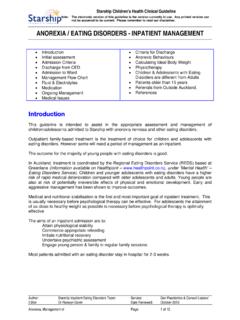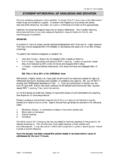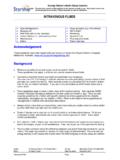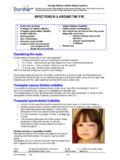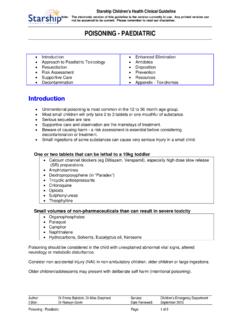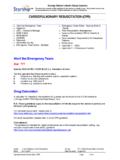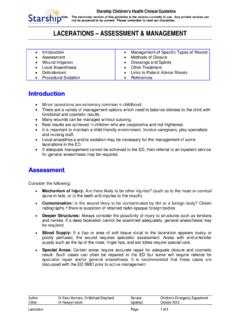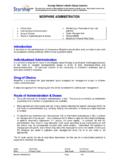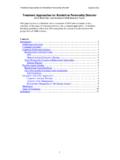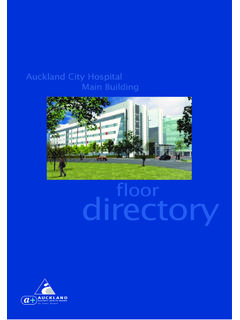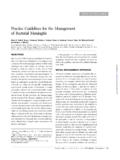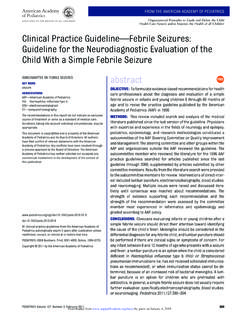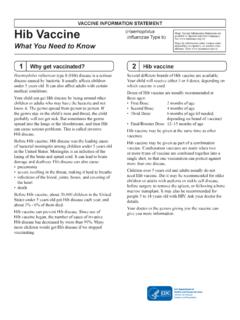Transcription of Pneumonia - Home | Auckland District Health Board
1 Starship children s Health Clinical Guideline Note: The electronic version of this guideline is the version currently in use. Any printed version can not be assumed to be current. Please remember to read our disclaimer. Pneumonia Author: Drs Best, Brabyn, Shepherd & Twiss Services: CED, Respiratory, ID, Gen Paeds Editor: Dr Raewyn Gavin Date Reviewed: August 2010 Pneumonia Page: 1 of 8 Introduction Clinical features Causative Organisms Investigations Treatment Admission Follow-up Recurrent Pneumonia or persistent symptoms Complications Prevention.
2 Environment & underlying conditions References IntroductionIntroductionIntroductionIntr oduction These guidelines may not be appropriate for the immunocompromised child or a child with chronic lung disease ( cystic fibrosis, bronchiectasis, neonatal chronic lung disease). Pneumonia , bronchiolitis and asthma are all common illnesses that result in children presenting with acute lower respiratory symptoms and signs. Antibiotics should be given to children with bacterial Pneumonia but not to children with bronchiolitis or asthma. The New Zealand population has high rates of Pneumonia , complicated Pneumonia and long term sequelae (eg bronchiectasis).
3 Pneumonia is more common and more severe in younger children . In Auckland the hospitalisation rate of those < 2 years is 11 times higher than those aged 4. Clinical FeaturesClinical FeaturesClinical FeaturesClinical Features Most children with Pneumonia present with cough or difficulty breathing, but only the minority of children with these symptoms have Pneumonia . Bacterial Pneumonia should be considered in children <3 years of age who present with fever > , chest recession and increased respiratory rate >50 breaths/minute. Older children with bacterial Pneumonia often present with difficultly breathing in combination with tachypnoea.
4 If wheeze is present in a preschool child, primary bacterial Pneumonia is unlikely however in school age children it may suggest Mycoplasma pneumoniae (see below). Tachypnoea is a key clinical sign Tachypnoea by age (World Health Organisation) < 2 months age > 60 breaths per minute 2- 12 months age > 50 breaths per minute 12 months to 5 years age > 40 breaths per minute If chest indrawing, nasal flaring, grunting or crepitations are also present then the probability of Pneumonia is increased further. Atypical presentations without obvious respiratory symptoms are not rare (abdominal pain and vomiting mimicking an acute abdomen, meningism mimicking meningitis).
5 Starship children s Health Clinical Guideline Note: The electronic version of this guideline is the version currently in use. Any printed version can not be assumed to be current. Please remember to read our disclaimer. Pneumonia Author: Drs Best, Brabyn, Shepherd & Twiss Services: CED, Respiratory, ID, Gen Paeds Editor: Dr Raewyn Gavin Date Reviewed: August 2010 Pneumonia Page: 2 of 8 Causative OrganismsCausative OrganismsCausative OrganismsCausative Organisms In developed countries the aetiology of community acquired Pneumonia has been defined by the child s age as well as the severity of the episode of illness.
6 Likely causative organisms by age group are shown in Table 1. Mycoplasma pneumoniae should be suspected in school age children especially if the onset of symptoms is insidious and/or the child has wheeze, headache or arthralgia. Cold agglutinins and serial mycoplasma serology may be helpful in confirming mycoplasma but seldom influence management decisions so aren t routinely recommended. Table 1: Aetiology of Pneumonia by Age Group in Developed Countries* Age group Predominant organisms** 0 to 1 months Group B streptococcus Gram negative organisms Chlamydia trachomatis Listeria monocytogenes 1 to 24 months Respiratory syncytial virus (RSV) and other viruses Streptococcus pneumoniae Haemophilus influenzae (non typeable) Bordetella pertussis 2 to 5 years Respiratory syncytial viruses (RSV) and other viruses Streptococcus pneumoniae Haemophilus influenzae (non typeable)
7 6 to 18 years Mycoplasma pneumoniae Chlamydia pneumoniae Streptococcus pneumoniae accounts for up to 30% Respiratory viruses account for < 15% of episodes * The proportion of Pneumonia due to bacteria increases with age and within each age group likelihood of bacterial infection increases with increasing severity. Other respiratory viruses = Influenza A and B, parainfluenzae 1-3 , adenoviruses, human metapneumovirus, human coronavirus. Mixed bacterial and viral infection can occur in up to 40%. ** Staphylococcus aureus is an important pathogen of serious Pneumonia to remember in all age groups InvestigationsInvestigationsInvestigatio nsInvestigations Many children with Pneumonia may be diagnosed and managed on clinical grounds alone.
8 Radiology does not reliably distinguish bacterial from viral Pneumonia so does not determine the need for antibiotics. A chest x-ray may be indicated if: Presentation is atypical There is diagnostic uncertainty Infants <3 months of age Child who is severely unwell Child has a history suggesting underlying respiratory disease Complications (such as effusion) are suspected (based on clinical signs or not making anticipated clinical progress). Starship children s Health Clinical Guideline Note: The electronic version of this guideline is the version currently in use. Any printed version can not be assumed to be current.
9 Please remember to read our disclaimer. Pneumonia Author: Drs Best, Brabyn, Shepherd & Twiss Services: CED, Respiratory, ID, Gen Paeds Editor: Dr Raewyn Gavin Date Reviewed: August 2010 Pneumonia Page: 3 of 8 Sputum, throat swabs and NPA for bacterial cultures do not help determine who should receive antibiotics. An NPA may be indicated for cohorting patients being admitted, for diagnosis of suspected viral Pneumonia (< 2years) and deciding who may benefit from antiviral medication such as oseltamavir. A blood culture is an insensitive test for bacterial Pneumonia in children however blood cultures should be considered in the unwell child with Pneumonia , especially the child suspected of having Staphylococcus aureus or complicated Pneumonia .
10 Fever magnitude, full blood count findings or CRP do not reliably differentiate viral from bacterial Pneumonia . TreatmentTreatmentTreatmentTreatment children suspected with bacterial Pneumonia should be treated with antibiotics. Antibiotics do not prevent Pneumonia in children with upper respiratory tract infections. In contrast to pneumococcal meningitis, respiratory infections with pneumococci with reduced susceptibility to penicillin have not been shown to have worse outcomes and decreased susceptibility can be overcome with the use of high oral or IV dosing of penicillin. 1. Oral Antibiotics Oral antibiotics will provide adequate coverage for most mild to moderate episodes of Pneumonia .
